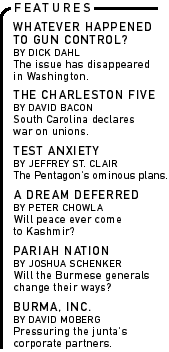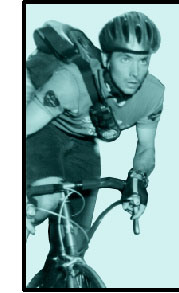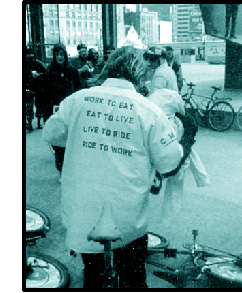|
|
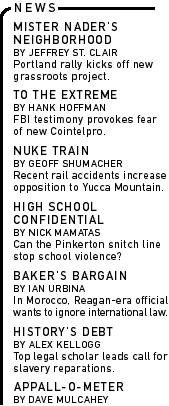
|
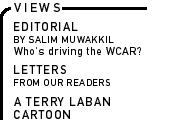
|
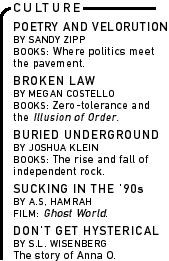
|
|
|
| |
|
|||
|
The Immortal Class: Bike Messengers Bike messengers seem out of place in the streets of our downtowns. Despised and envied by the "suits" they serve all day, messengers are simultaneously outside commerce and nothing more than commerce. They thumb their noses at workaday propriety while turning their very bodies into mere shuttles for the push and pull of business transaction. Their sweaty labor seems almost anachronistic in our supposed new clean keyboard utopia, some relic from a decidedly archaic world where information has to assume material form to move. And yet they're the communications system of the real-world network, transmitters endlessly coursing across the spaces between nodes on the grid. They are both isolate flecks in the data stream and potential connection points between labor and the information economy, bearers of new public visions and a possible politics. In The Immortal Class: Bike Messengers and the Cult of Human Power, Travis Hugh
Bike messengering begins for Culley as nothing more than a job, a way to support his ambitions in the theater. But by the end of the book, it's a way of life, galvanizing his participation in Critical Mass--the monthly bike-ride-cum-protest held in cities around the world--and other bike activism of the mid-to-late '90s. Culley matures as a messenger while the Chicago bike insurgency comes into its own, earning the ire and retribution of Mayor Daley's police. The narrative here covers both stories; perhaps Culley's most subtle and important achievement is bringing day-to-day toil and transportation politics into close conversation. "The bicycle," he writes, "is a revolution, an assault on civilian territory, intent on taking, from the ground up, responsibility for the shape of our cities. It is a mutiny, challenging the ever-one-way street. The bicycle is a philosophy, a way of life, and I am using it like a hammer to change the world and to redeem our war-torn cities." This kind of manifesto-speak, smashing along with its "assaults" and "mutinies," seems ill-fitted for any lasting sense of "responsibility for the shape of our cities." Still, Culley's brief, impressionistic forays into urban history--he makes a detour into the long-term failure of Daniel Burnham's 1909 City Beautiful plan for Chicago--make it plain that generations of "accredited" planners have bungled the job already, giving American cities over not to people, but to cars. And, in stumping for the human-powered transportation revolution, Culley demands a hearing for new kinds of urban knowledge, for the street-level experiences around which cities might be shaped, and for humility before city overload. "You may say my perspective is unaccredited," he writes, "but in the face of clouds reflecting across a sea of steel surfaces, concerning the meaning of street signs and the way the heart sinks at the sight of a tide of fuming freight trucks, who can claim to be anything other than an amateur? Can anyone really be authorized to cast a net over all this?" Sometimes such passages seem to overreach. Still, Culley's editor had the sense to let him write; without his voice, without these flights of fancy we might never believe that any of this matters, that one might find anything other than drudgery in running errands for businessmen. Luckily for the reader, his undisciplined, rangy account gives grit to his more removed meditations. The political and ethical visions that undergird Culley's polemic begin in his personal immersion in the details of work, in the imaginative resources brought to bear on labor that give purpose to routine. A friend of mine once observed that there is a certain soul to the job of messengering. It's in making a steady, motionless track stand at a busy intersection or a graceful, soundless curb hop paired with a fluid dismount and lock-up. It's in the sight of a rider, up out of the saddle, weaving and ducking through a rush-hour traffic morass in the last of the day's light. Culley, too, contributes his own aesthetic indulgences. For instance, he attempts to reveal in prose the "kinetic intelligence" of riding in traffic: "When riding I do not concentrate on what my hands and feet are doing. I focus on the space at hand, what is there, what is not there, and what is coming into being. I rarely dodge. It's more like I swim toward emptiness, analyzing what is in front of me by the speed with which it comes at me. I am not moving through space as much as I am expanding space where, in speed, it seems to fall away." Even more, he reveals what it feels like to spend all day, every day on a bike, how he takes account of the city beneath the wheels and makes his own mental geography. Every straightaway, descent and climb; every pothole and bump course up through the wheels, fork and frame and into his legs, measuring distance in fatigue and endurance. He gradually comes to understand how messengers measure the landscape with a cartographic eye, learning to navigate the city streets by a subtle meld of experience and intuition. They feel their way over the raw geography undergirding the pavement, steadily collecting the lore of two-wheeled transit: which streets have the most treacherous streetcar tracks or subway grates, which have cratered pavement or daunting climbs, which combination of streets delivers the most satisfying ride. He discovers an underground Chicago, a series of roadways and garages beneath the surface streets amongst the skyscraper foundations, "a hidden zone for taxis, freight trucks, suburbanites, and wild-eyed messengers on scratched-up racing bikes." These urban discoveries ensure that Culley won't accept a cubicle-bred myopia about the city and the variousness of its streets. Instead, the book gives a strong sense of the pragmatic interconnection, both geographic and imaginative, fostered by bike messengering. This connection--whether to fellow riders, the city or even drivers--becomes the basis of a politics of redemption, a blueprint for bringing those many worlds into a kind of rough conversation. Even if cities are now made for cars instead of people, it seems to bother most people
But after months of random harassment, the police decide to drive the monthly bike cavalcade from the streets, setting an ambush for the September 1998 ride. They arrest almost 15 riders, precipitating an angry protest in front of a station house. The cops attack there too, making more arrests, trying to disperse the protest with batons and fists. The police clampdown leaves Culley demoralized, and not long after he gets off the road, taking a job at a museum. Then, the next spring, a driver runs down and kills a messenger in a fit of road rage. Culley joins an anguished memorial Critical Mass for the downed rider, a guy he had known. The event is somber and tense, and at the scene of the crime the riders are confronted by the jailed killer's family. They seem to believe the messenger had no right to the road, and thus his life. Still, there's something cathartic for Culley in the ride, and as it makes its way back to the Loop, he brings the narrative together from the middle of the rolling crowd. That day and in the days afterward, as the messenger community grieves, he begins to catch sight of a way out of the madness, a vision of "a sustainable Chicago covered with bikes-only streets, quiet trains, and a patient, car-free, delivery based roadway. ... For the bicycle and the culture that supports it, we are helping to give the city a resurrection, a second coming of the City Beautiful, a second chance at really working." Culley's book has aroused some ire in the insular and self-protective messenger scene. Initially conceived as an anthology of writings by messengers and bike activists, the project was deemed unsaleable by all the publishers who looked at the proposal. However, a few asked to see a memoir from Culley instead. Giving in to the demands of marketing, Culley went to work on the memoir, meanwhile forgetting to tell some of his former contributors that plans for the anthology were off. Despite his successful efforts to honor the messenger community, the result certainly reads, not surprisingly, more like Culley's own imaginative take on messengering than an insider's account. But The Immortal Class is more than than a communique from
a quirky subculture. Culley makes the details of everyday work and
the dignities of a considered way of life resonate with a political
vision for a sustainable city. His exuberance pushes The Immortal
Class beyond the solipsistic realm of memoir into the haphazard
but ultimately more rewarding terrain of poetic testimony for an
emerging social movement. Sandy Zipp wrote "The Battle of San Francisco" in the April 2 issue.
|




